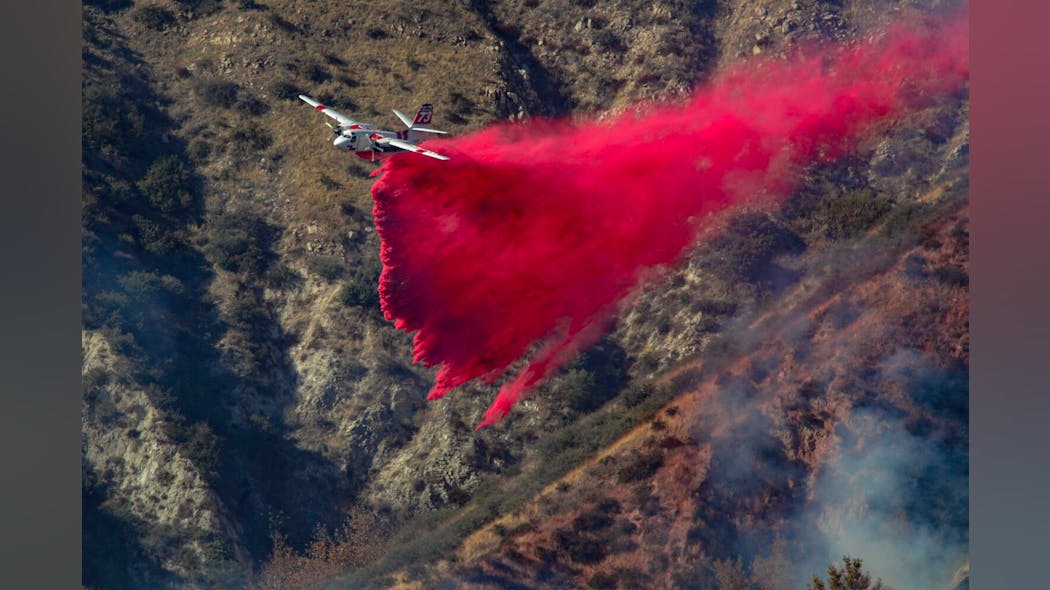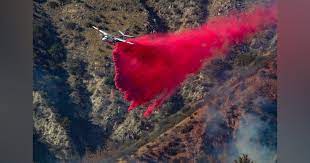March 29, 2023 The neon pink ammonium phosphate-based retardant which also is used as fertilizer kills aquatic life, the suit claims.
By Alex Wigglesworth Source Los Angeles Times (TNS) Distributed by Tribune Content Agency, LLC.

For most Californians, the sight of aircraft spewing neon pink liquid over flaming trees and brush has become a hallmark of aggressive wildfire suppression campaigns — if not a potent symbol of government’s struggle to control increasingly destructive forest fires.
But as the use of aerially delivered retardant has soared in recent years, some forest advocates say the substance does more harm than good. They claim wildfire retardant drops are expensive, ineffective and a growing source of pollution for rivers and streams.
“There’s no scientific evidence that it makes any difference in wildfire outcomes,” said forester Andy Stahl. “This is like dumping cash out of airplanes, except that it’s toxic and you can’t buy anything with it because it doesn’t work.”
Now, a federal lawsuit in Montana that seeks to stop the U.S. Forest Service from dropping retardant into water could reshape how the agency battles wildfires throughout the western United States.
The case is being watched particularly closely by officials in California, where an extremely wet winter is likely to stoke the growth of so-called connecting fuels — grasses that can carry small flames from a spark on a roadway to chaparral and forested areas.
“This is going to destroy towns and many communities in California, if they allow this to go through,” said Paradise Mayor Greg Bolin, whose town was razed by the Camp fire in 2018. “To maybe save a few fish, really?”
The lawsuit, filed by the Forest Service Employees for Environmental Ethics, of which Stahl is executive director, accuses the Forest Service of violating the Clean Water Act, which prohibits the discharge of pollutants into U.S. waters without a permit.
The action comes as more retardant is being dropped from the air than ever before amid longer, more active fire seasons. In 2021, 52.8 million gallons of retardant were dumped on federal, state and private land, compared with a 10-year average of about 39 million gallons per year, according to figures provided by the Forest Service. More than half of the retardant the Forest Service used on national forest lands was dropped in California — more than any other state.
The Forest Service primarily uses ammonium phosphate-based retardant, which is intended to coat vegetation and other fuels around the edges of a fire to deprive advancing flames of oxygen. The goal is to slow fire spread and lessen its intensity so crews on the ground get a chance to directly attack it.
But the chemical, which is also used as fertilizer, can kill aquatic life. For example, in Santa Barbara County, dozens of endangered steelhead trout were killed in Maria Ygnacio Creek during the 2009 Jesusita fire. UC Santa Barbara scientists documented elevated ammonia levels in the water and concluded the fish kill was likely due to retardant drops.
The Forest Service has dropped more than 760,000 gallons of retardant into water, both accidentally and under an agency directive that such drops are permissible if they mitigate threats to human life or public safety, according to figures the agency released last year.
Plaintiffs in the case have asked the court to enjoin the Forest Service from spilling retardant into waterways. However, the Forest Service contends in court documents that the only way to do so is to stop using retardant altogether — an action that they say would deprive the service of a crucial firefighting tool.
Plaintiffs, however, say the Forest Service could instead increase the width of buffer zones alongside waterways where no retardant can be dropped.
After the suit was filed, the Forest Service asked the Environmental Protection Agency to develop a general permit to cover the discharge of retardant into waterways. The EPA estimates the process will take about 2½ years.
Facing the potential prospect of the Forest Service not being able to apply retardant from the air for more than two years, more than a dozen communities and interest groups have petitioned to intervene in the case. They include Paradise, Butte and Plumas counties in California and trade organizations representing private firefighting companies, the timber industry and agriculture.
“The impacts that everybody is experiencing in California and beyond are so dramatic that we have no option other than to build a coalition to try to cease any action that would result in a higher risk as it relates to wildfire damages,” said Matt Dias, chief executive of the California Forestry Assn.
Members of the trade group, which represents lumber mills, veneer plants and biomass facilities in the state, have lost hundreds of thousands of acres to wildfire over the past several years, he said. The effects extend beyond the forest products industry to include the loss of hundreds of lives, the depletion of carbon stocks and recreational opportunities, the degradation of air quality and the economic devastation of rural communities, he added.
“My understanding is that fire retardant is not good for waterways, but think of the other side of it,” said Butte County Supervisor Doug Teeter, who lost his home in the Camp fire. “A massive forest fire burning down a huge amount of acreage is probably worse for the environment.”
The Camp fire was the deadliest wildfire in California history, killing 84 people. Although retardant was unable to be used to save Paradise because the blaze moved too quickly, generating 100-mph winds and thick clouds of black smoke that grounded air tankers, retardant did stop the flames from spreading to nearby Chico and Durham, Bolin said.
The legal wrangling prompted U.S. Reps. Doug LaMalfa (R- Richvale) and Jimmy Panetta (D- Carmel) to on March 14 introduce a bill that would explicitly exempt firefighting agencies from having to obtain a permit for retardant use.
The lawsuit is the latest salvo in a decades-long battle between FSEE and the Forest Service over the agency’s use of retardant. The nonprofit first sued the Forest Service in 2003 for failing to conduct the appropriate environmental analyses to use aerial retardant; a federal court ruled the agency must do so. The nonprofit again sued the Forest Service in 2008, alleging its environmental analysis was inadequate, and the court ruled the Forest Service had to do a more thorough analysis by the end of 2011.
That’s when the Forest Service agreed to map out exclusion areas where it would refrain from dropping retardant absent a risk to public safety, including buffers around vulnerable species habitat and waterways. The EPA told the agency at the time that if pilots complied with these guidelines, they would not need a permit, as they would not be discharging retardant into waterways.
But in a report released last year, the Forest Service admitted that it had dropped more than 1 million gallons of retardant into exclusion areas on 459 occasions from 2012 through 2019. Retardant landed in water on 213 of those occasions, representing less than 1% of the roughly 56,868 retardant drops the Forest Service made during that time frame, the agency said in court documents.
While the lawsuit primarily concerns the dropping of retardant into water, the issue of whether it works as intended has also been raised in court documents.
The Forest Service has argued that a prohibition on discharges of retardant into water would impair its firefighting capabilities and jeopardize safety, doing a disservice to the public interest. The FSEE has argued however that the agency lacks evidence that aerial retardant actually accomplishes those goals.
Studies performed by Forest Service scientists have concluded that aerial retardant slows fire spread in laboratory-based and experimental fires, but that its effectiveness in the field is dependent on environmental conditions like slope, fuel type, terrain and weather.
“Aerial retardant is effective over a narrow range of conditions, and the windows of opportunity for those conditions are narrowing each year due to climate change,” said Timothy Ingalsbee, a former wildland firefighter and executive director of the nonprofit Firefighters United for Safety, Ethics and Ecology, which is not involved in the lawsuit.
Retardant is most effective when used in the cool of the morning on relatively level terrain with sparse vegetation during the initial attack of small fires burning near communities, he said. Ground crews must be nearby to take advantage of the reduced rate of spread by cutting containment lines; otherwise, the fire may slow only temporarily and then keep spreading, he said.
And yet, Ingalsbee said, research has shown that retardant is often dropped in the heat of the afternoon during the extended attack of large fires burning on steep, densely forested slopes in remote areas where ground crews can’t reach, or when fire behavior is so intense that it’s too dangerous for ground crews to engage.
“The Forest Service feels pressure to do something, as much for public relations as any operational benefit,” he said. “But it’s just a big airshow.”
